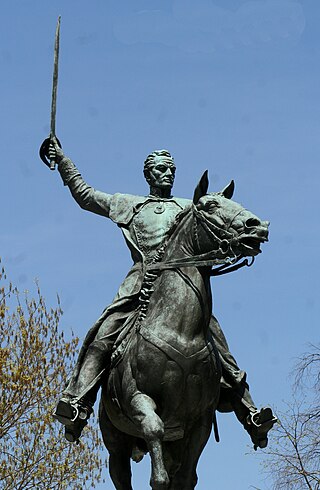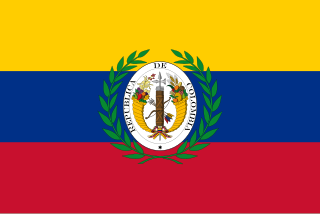
Departments of Colombia refer to the administrative divisions of Colombia. As of 2024, the unitary republic is made up of thirty-two departments. Each department has a governor and an assembly, elected by popular vote for a four-year period.

The military and political career of Simón Bolívar, which included both formal service in the armies of various revolutionary regimes and actions organized by himself or in collaboration with other exiled patriot leaders during the years from 1811 to 1830, was an important element in the success of the independence wars in South America. Given the unstable political climate during these years, Bolívar and other patriot leaders, such as Santiago Mariño, Manuel Piar, José Francisco Bermúdez and Francisco de Paula Santander often had to go into exile in the Caribbean or nearby areas of Spanish America that at the moment were controlled by those favoring independence, and from there, carry on the struggle. These wars resulted in the creation of several South American states out of the former Spanish colonies, the currently existing Venezuela, Colombia, Ecuador, Peru and Bolivia, and the now defunct Gran Colombia.

United States of Colombia was the name adopted in 1863 by the Constitución de Rionegro for the Granadine Confederation, after years of civil war. Colombia became a federal state itself composed of nine "sovereign states.” It comprised the present-day nations of Colombia and Panama and parts of northwestern Brazil. After several more years of intermittent civil wars, it was replaced by the more centralist Republic of Colombia in 1886, predecessor to modern Colombia.

The First Republic of New Granada, known despectively as the Foolish Fatherland, is the period in the history of Colombia immediately following the declaration of independence from Spain in 1810 and until the Spanish reconquest in 1816. The period between 1810 and 1816 in the Viceroyalty of New Granada was marked by such intense conflicts over the nature of the new government or governments that it became known as la Patria Boba. Constant fighting between federalists and centralists gave rise to a prolonged period of instability that eventually favored Spanish reconquest. Similar developments can be seen at the same time in the United Provinces of the Río de la Plata. Each province, and even some cities, set up its own autonomous junta, which declared themselves sovereign from each other.

The New Kingdom of Granada, or Kingdom of the New Granada, was the name given to a group of 16th-century Spanish ultramarine provinces in northern South America governed by the president of the Royal Audience of Santafé, an area corresponding mainly to modern-day Colombia. The conquistadors originally organized it as a province with a Royal Audience within the Viceroyalty of Peru despite certain independence from it. The audiencia was established by the crown in 1549.

The United Provinces of New Granada was a country in South America from 1810 to 1816, a period known in Colombian history as la Patria Boba. It was formed from areas of the New Kingdom of Granada, roughly corresponding to the territory of modern-day Colombia. The government was a federation with a parliamentary system, consisting of a weak executive and strong congress. The country was reconquered by Spain in 1816.

The Republic of New Granada was a centralist unitary republic consisting primarily of present-day Colombia and Panama with smaller portions of today's Costa Rica, Ecuador, Venezuela, Peru and Brazil that existed from 1831 to 1858. The state was created after the dissolution of Great Colombia in 1830 through the secession of Ecuador and Venezuela. In 1858 the state was renamed into the Granadine Confederation. On 9 May 1834, the national flag was adopted and was used until 26 November 1861, with the Gran Colombian colours in Veles' arrangement. The merchant ensign had the eight-pointed star in white.

The Granadine Confederation was a short-lived federal republic established in 1858 as a result of a constitutional change replacing the Republic of New Granada. It consisted of the present-day nations of Colombia and Panama and parts of northwestern Brazil. In turn, the Granadine Confederation was replaced by the United States of Colombia after another constitutional change in 1863.
Veragua or Veraguas was the name of five Spanish colonial territorial entities in Central America, beginning in the 16th century during the Spanish colonization of the Americas.

The Colombian Civil War began on 8 May 1860 and lasted until November 1862. It was an internal conflict between the newly formed conservative Granadine Confederation and a more liberal rebel force from the newly seceded region of Cauca, composed of dissatisfied politicians commanded by General Tomás Cipriano de Mosquera, its former president. The Granadine Confederation, created a few years earlier in 1858 by Mariano Ospina Rodríguez, was defeated in the capital Bogotá, with Mosquera deposing the newly elected president Bartolomé Calvo on July 18, 1861. Forming a provisional government, with himself as president, Mosquera continued to pursue the conservative forces until their final defeat in 1862. The resulting formation of the new United States of Colombia would have significant cultural and economic consequences for Colombia.

Gran Colombia, or Greater Colombia, officially the Republic of Colombia, was a state that encompassed much of northern South America and part of southern Central America from 1819 to 1831. It included present-day Colombia, mainland Ecuador, Panama, and Venezuela, along with parts of northern Peru, northwestern Brazil, and claimed the Essequibo region. The terms Gran Colombia and Greater Colombia are used historiographically to distinguish it from the current Republic of Colombia, which is also the official name of the former state.
The constitutional history of Colombia is the process of formation and evolution of the different constitutions that Colombia has had since its formation.

The Department of the Isthmus was one of the departments of the Republic of Gran Colombia. It was created in 1824 and named after the Isthmus of Panama. It covered the territory of what is now the country of Panama and some disputed coastal territories farther northward along the Caribbean shoreline of present-day Costa Rica and Nicaragua.

According to the Political Constitution of Costa Rica of 1949, in article 168, the territorial division of Costa Rica is organized by law into three types of subnational entity:

Cartagena Province, also called Gobierno de Cartagena during the Spanish imperial era, was an administrative and territorial division of New Granada in the Viceroyalty of Peru. It was originally organized on February 16, 1533 as a captaincy general from the central portion of the Province of Tierra Firme. In 1717, King Philip V of Spain issued a royal decree creating the Viceroyalty of New Granada, by which the province was added to the latter.

States of Colombia existed from February 27, 1855, in the Republic of New Granada and the Granadine Confederation, where they were called "federal states". In the United States of Colombia they were called "sovereign states".

The Panama State, officially known as the Federal State of Panama from 1855 to 1863, and as the Sovereign State of Panama from 1863 until 1886 when it was dissolved, was established as one of the states of the Republic of Gran Colombia established in 1821 after independence from the Spanish Empire and was later part of the Republic of New Granada, the Granadine Confederation, and the United States of Colombia. The state was established on 27 February 1855 and lasted until 1886 when it was replaced by the Department of Panama. In 1903, the territory of the Panama State achieved independence as the Republic of Panama.

The 1827 Guayaquil uprising, also known as the Guayaquil Department rebellion, was a rejection of the centralist policies of Gran Colombia. This was one of the first separatist rebellions in the country of Gran Colombia before it dissolved in 1829.

The Colombian–Peruvian territorial dispute was a territorial dispute between Colombia and Peru, which, until 1916, also included Ecuador. The dispute had its origins on each country's interpretation of what Real Cedulas Spain used to precisely define its possessions in the Americas. After independence, all of Spain's former territories signed and agreed to proclaim their limits in the basis of the principle of uti possidetis juris, which regarded the Spanish borders of 1810 as the borders of the new republics. However, conflicting claims and disagreements between the newly formed countries eventually escalated to the point of armed conflicts on several occasions.
The history of the territorial organization of Spain, in the modern sense, is a process that began in the 16th century with the dynastic union of the Crown of Aragon and the Crown of Castile, the conquest of the Kingdom of Granada and later the Kingdom of Navarre. However, it is important to clarify the origin of the toponym Spain, as well as the territorial divisions that existed previously in the current Spanish territory.
















